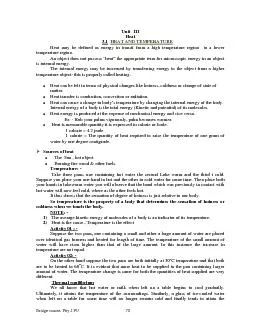/


HEAT AND TEMPERATURE Heat may be defined as energy in transit from a high temperature region to a lower temperature region An object does not possess ID: 507569
Download Pdf The PPT/PDF document "Bridge course- Phy-I PU 70 Unit III He..." is the property of its rightful owner. Permission is granted to download and print the materials on this web site for personal, non-commercial use only, and to display it on your personal computer provided you do not modify the materials and that you retain all copyright notices contained in the materials. By downloading content from our website, you accept the terms of this agreement.
Bridge course- Phy-I PU 70 Unit III Heat HEAT AND TEMPERATURE Heat may be defined as energy in transit from a high temperature region to a lower temperature region. An object does not possess heat the appropriate term for microscopic energy in an object Suppose the two pans, one containing a small and other a large amount of water are placed over identical gas burners and heated for length of time. The temperature of the small amount of We all know that hot water or milk when left on a table begins to cool gradually. Ultimately, it attains the temperature of the surroundings. Similarly, a glass of ice-cooled water when left on a table for some time will no longer remain cold and finally tends to attain the Bridge course- Phy-I PU 71 temperature of the surroundings. This shows that when two bodies at different temperatures come in contact with each other the hotter body becomes cooler and the colder becomes warmer. Finally a state is reached when no heat is flow from one body to other. The state when no heat is exchanged between the two bodies in contact with each other is known as the state of thermal equilibrium.At this stage two bodies are said to be at the same temperature. Measurement of temperature :- Measurement of temperature is based on the effect on the change of physical property of the matter due to transference of heat. Ex: - Expansion of solids and liquids Increase of volume/ pressure at constant pressure/volume of a gas Change in electrical resistance of a piece of metallic wire Setting up of electromotive force at the junction of two dissimilar metals Change in vapour pressure Change of chemical phase of a system etc. An instrument based on any of the above thermometric property is called a thermometer. Temperature scales :- Some specific temperature on different scales of temperature under normal conditions oC Fahrenheitscale K Bridge course- Phy-I PU 72 Types of thermometers Liquid thermometers:- It works on the principal of change in volume of liquid with change in temperature. Gas thermometers :- It works on the principal of change in the pressure with change in temperature.Platinum resistance thermometer :- It works on the principal of change of resistance with change of temperature.Thermoelectric thermometer : - It works on the principal of change of Thermo emf with change in temperature.Radiation pyrometers:- It works on the principle of amount of radiation falls .Bimetallic strip thermometer: - It works on the principle of linear expansion of solid with temperature.Questions Write the differences between heat and temperature A thermometer is kept in direct sun light what does it measure temperature of air or temperature of sun. What is the temperature of vacuum? Why a thick glass tumbler does break when a hot liquid is poured in it? A thin rod and a thick rod of the same material are allowed to expand by giving the same amount of heat which expands more? What does the temperature scale on the thermometer measure? Imagine you put a thermometer in your mouth. How does the heat flowing from your mouth affect the atoms in the thermometer? Answers Sl No Heat Temperature 1 It is a form of energy It is a measure of degree of hotness of a body 2 Heat is responsible for temperature It is one of the effects of heat 3 It is the sum of energies of all molecules It is the average kinetic energy of the molecules 4 S I unit is joule S I unit is Kelvin 2) Temperature of air 3) No. If you have a perfect vacuum, it has no temperature. Temperature is a measure of how fast the molecules of the medium are moving, and with no molecules to measure, temperature is meaningless. The inside of the glass expands faster because the heat comes to it faster than the outside so it cracks under pressure. 6) It measures the average Kinetic Energy of a substance. In other words, it measures the average motion of the molecules in a substance. 7) Heat flows from warm places to cooler places. Thus, heat is conducted into the cooler thermometer. The heat causes the molecules in the thermometer to vibrate more quickly. The increased kinetic energy of the atoms causes them to spread out and rise up the tube. The end result is that you can read your body temperature.